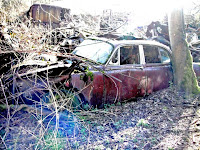Final Collage:
I
have added the caption 'Osborne's Paradise?', because George Osborne is the
chancellor of the United Kingdom, and therefore responsible for the county's
economy. I thought that because of how Osborne has caused the closure of many
businesses, this may have been his plan, and wants Britain to fall into a deep
state of depression. Also, the word 'paradise' links with somewhere you enjoy
being (Osborne may enjoy being in a failing country?), and also to the palm
trees which I added using block prints.
Overall, after the enhancement on Photoshop, I think my Collage is quite effective. It attracts attention due to the deep colours and use of blank space. Also, the use of ink spillages around the photos adds to the sense of disarray- making the collage appear old and dark.
Alternative Idea:
In order to develop this idea, I took more photographs. I have aimed to give the collage a less serious theme while still appealing to the phrase 'it's the end of the world as we know it'. This time I used digital techniques (i.e. altering the threshold and contrast), and I put the photos together using Photoshop. This was much easier as I could alter the size and location of the images whenever necessary.
The crude effects implemented on the background photographs are supposed to amplify the neglect and decimation of the scene, and make the photographs appear as if they have been photocopied. The addition of the seagulls creates a story, and makes you question why they are included (did they cause this destruction?). Also, the way they appear to be looking at the viewer gives a sinister edge to the collage.

































